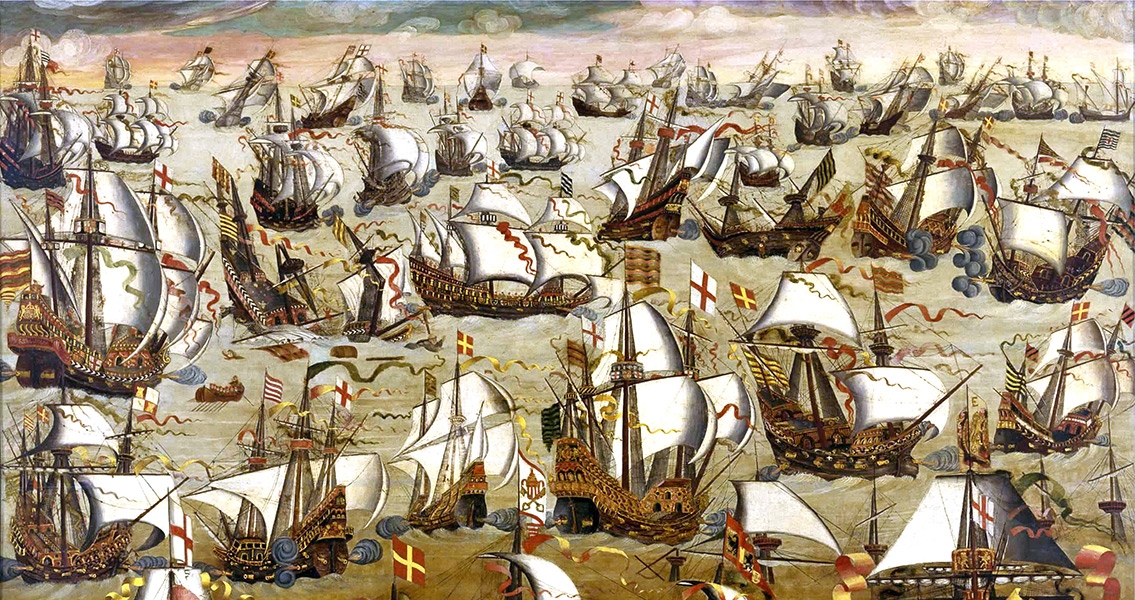<![CDATA[On 20th July, 1588, the Spanish Armada set sail from Corunna in Spain with the mission of escorting an army from Flanders to invade England. The attempt to invade England would result in a spectacular defeat for the Spanish Armada and a celebrated victory for the English navy, proving a key moment in establishing England's naval dominance. Spain had a formidable military reputation at this point, and the threat of invasion had hung over England for several years prior to the attempt in 1588, as a result of simmering diplomatic tensions and occasional skirmishes. The Spanish Armada first set sail from Lisbon in May 1588. Led by the Duke of Medina-Sidonia, it consisted of 130 ships crewed by a total of 8,000 seamen and armed with 2,500 cannon. The fleet transported an army of some 20,000 troops. On 19th June the immense Spanish Armada reached Corunna, where it stopped to take on supplies of food and water, and wait for an opportune moment to launch its attack on England. Meanwhile, aware that the invasion was being prepared, English ships were sent out to try and locate the Armada's position and gather information. King Philip II of Spain had a number of motivations behind his decision to launch the invasion of England. In the sixteenth century the Netherlands were a part of the Spanish Empire. The Spanish Inquisition enforced a strict Catholic regime on the Dutch, pushing the country's increasingly Protestant population into hiding. England, which under Queen Elizabeth's rule was a Protestant country, had been lending support to the Protestant rebels in the Spanish Netherlands, angering both king Philip and the Catholic church in Rome. The actions of English 'sea dogs', most notably Sir Francis Drake, against Spanish shipping were another cause of frustration for king Philip. For years Drake had been launching raids on Spanish ships in the West Indies and off Spain's coast, stealing their cargo and often sinking the ships. The constant raids were costing the Spanish crown huge amounts of money, and Sir Francis Drake was viewed as nothing more than a state backed English pirate. In 1587, Mary Queen of Scots was executed on orders from Queen Elizabeth. England's transition to Protestantism had long been a cause of friction between it and the Catholic countries of Europe. The execution of Mary was seen as a marker of the brutality with which Protestant's would treat Catholics remaining in England. As such, Philip used the execution as further justification to send the Spanish Armada to invade, as a way to protect other Catholics from Mary's fate. After departing Corunna, the Spanish Armada advanced up the English Channel. The English Navy, under the leadership of Sir Francis Drake, bombarded the ships as they passed, using their advanced cannons to attack the Spanish from a safe position. Two galleons were sunk by the English in a series of battles around the coast, but otherwise the Spanish ships' reinforced hulls allowed them to progress relatively unscathed. The biggest problem for the Spanish arose when they were forced to stop to pick up the army from Flanders. With no appropriate port in the Netherlands, the Spanish ships were forced to head to Calais on 6th August and wait for the soldiers to march south. Sir Francis Drake realised that the only way to achieve victory over the Spanish was to force the Armada to break its tight formation. Overnight, eight English fire ships were launched into the Spanish fleet at Calais, causing chaos and forcing the Spanish Armada to scatter. With the Spanish formation broken, Drake ordered an attack on the Armada. Although bad weather meant the English attack was not as devastating as they might have hoped, sinking only three galleons, it achieved the required result. The Spanish Armada was now blocked off from heading south down the English channel. It could not pick up the army in Flanders, and it could not return to Spain via the channel. The Armada was left with no choice but to sail home via Scotland, going around the entire British Isles. Perilously short on supplies, and sailing through one of the worst storms in history, it is estimated that only sixty seven of the Spanish ships made it back to Spain, with some 20,000 Spanish soldiers dying from disease or starvation on the journey. ]]>
Spanish Armada Sets Sail From Corunna
